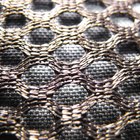
Thinkstock Images/Comstock/Getty Images
First marketed by DuPont in 1967, Nomex is a trademarked brand of heat-resistant, flame-resistant fiber used to outfit and protect firefighters, first responders, racecar drivers and industrial workers. Nonclothing applications include hot-gas filtration and electrical applications.
Nomex comes in its original version and a static-resistant version called Nomex IIIA. Laundry instructions are the same for both types of fabric. No special or unusual detergents are required, but be attentive to Nomex's care and handling during the cleaning process, and wash before wearing.
Remove flammable soils or chemicals. You cannot "wash away" Nomex's flame-resistant properties; however, if flammable materials build up on your Nomex apparel, they could burn and act as fuel, negating the FR capability. Remove such buildup and stains with pretreatment agents before laundering.
Wash separately from other clothes in bleach-free detergent, and sort by color for best results. You can wash Nomex clothes as you would normal clothes, but keep them away from clothes that lint and pill, and separate your garments so that darker colors do not bleed and discolor lighter-colored garments. Do not mix with other clothes if soiled with contaminants that you would not otherwise include in the wash.
Clean Nomex apparel in water of softness of less than 4.0 grains. Avoid using hard water, which will leave mineral deposits on the fabric and undo its flame resistance by serving as fuel should the garment be ignited. Use higher pH detergent products with caution, as they could produce color loss.
Launder Nomex garments at temperatures up to 140 degrees F. Higher temperatures remove tougher stains and will not affect Nomex's heat or flame resistance, but they could adversely affect color. Color-fastness will not be as strong as in cotton-polyester blends.
Dry clothes on the "permanent press" setting, and make sure the fabric temperature in the basket does not exceed 280 degrees F. Cool down to 100 degrees F, and remove immediately from the dryer. The material dries quickly, so do not overdry, as this will accelerate color fading.
Related Articles

The Care of Plisse Fabric

How to Clean Cotton-Polyester Blend ...

How to Clean a Polyester Coat

How to Wash Cotton Clothes

How to Wash Cotton Fabric

How to Wash & Dry Clothes So They Do ...

How to Dye Leotards

How to Clean Viscose Shawls

How To Wash T-Shirts So They Won't ...

How to Wash Dupioni Silk

Care of Mohair Fabric

How to Remove Color From White Clothes ...

How to Get Rid of an Ammonia Odor on ...

How to Wash Viscose Clothing

How to Bleach Mens' Dress Shirts

Rayon Spandex Care Instructions

Can You Iron Acetate Fabric?

How to Remove Wrinkles From Polyester ...

How to Avoid Stretching out Acrylic ...

How to Remove Blue Jean Dye Stains from ...
References
Writer Bio
Timothea Xi has been writing business and finance articles since 2013. She has worked as an alternative investment adviser in Miami, specializing in managed futures. Xi has also worked as a stockbroker in New York City.
Photo Credits
Thinkstock Images/Comstock/Getty Images